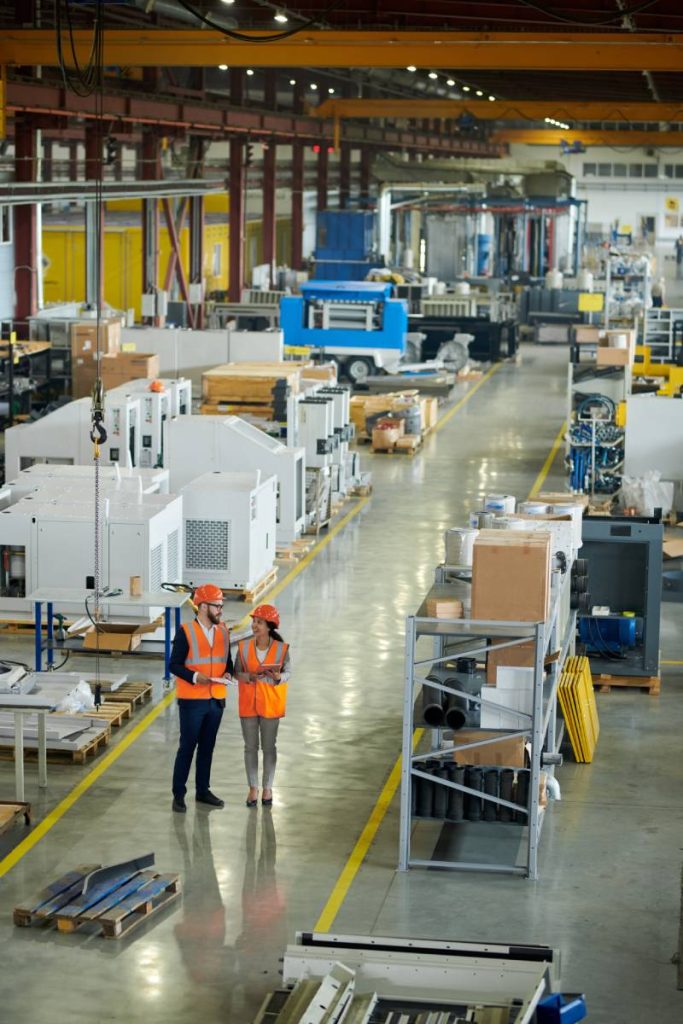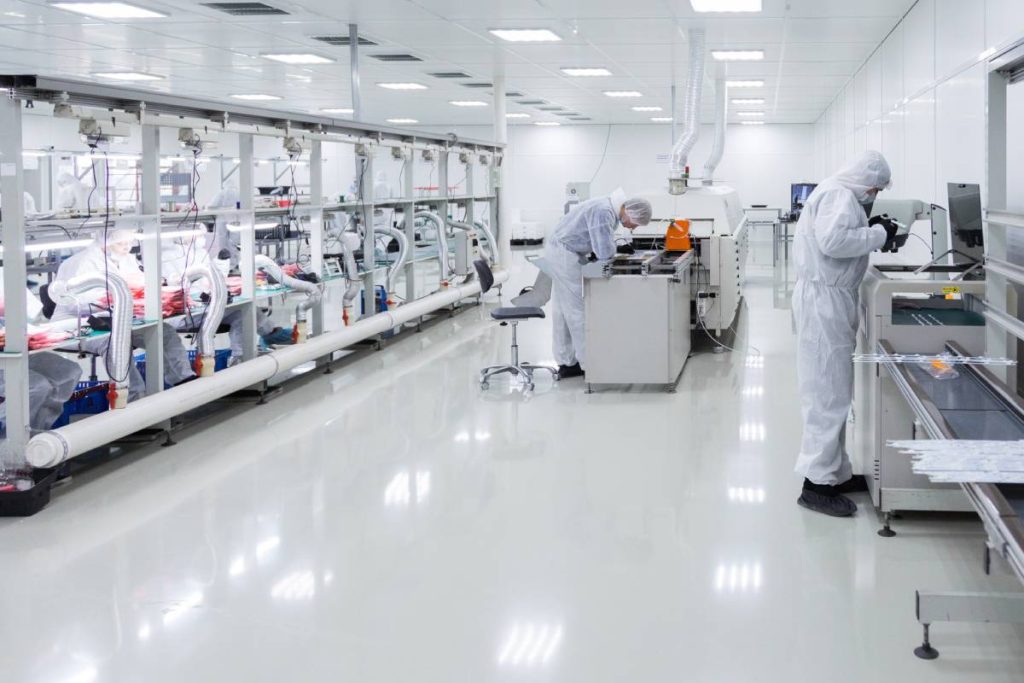In today’s world, electronic equipment powers our industries and drives innovation. But the invisible force of static electricity is a real headache. Electrostatic Discharge (ESD) is not just annoying; it can also be a potential threat to the integrity of our equipment, the safety of our people, and the reliability of our operations. That’s where ESD flooring comes in handy as a crucial line of defence.
In this article, we’ll see why ESD flooring is a must-have in various industries. We’ll look at how it helps protect sensitive equipment, prevent product damage, ensure personnel safety, comply with industry standards, and keep operations running smoothly.
Related article:
What is ESD Floor?
An Electrostatic Discharge (ESD) floor, also known as an anti-static floor, is a specially designed type of flooring that helps to prevent the buildup and discharge of static electricity. These floors are commonly used in environments where static electricity can cause damage to sensitive electronic equipment or pose a safety hazard to personnel.
ESD floors are typically made from materials that have a high level of electrical conductivity or dissipative properties. This means that they can either conduct static electricity away from the surface or dissipate it safely to prevent the buildup of static charges.
There are several different types of ESD flooring available, each with its own unique properties and applications. Some common types include:
- Vinyl Tile Flooring: Vinyl tile flooring is one of the most popular choices for ESD flooring. It is durable, easy to clean, and comes in a variety of colours and designs. Vinyl tile flooring is often used in commercial and industrial settings where static control is essential.
- ESD Carpeting: ESD carpeting is another option for environments where a softer, more comfortable flooring solution is desired. These carpets are made with special fibres that help to dissipate static electricity, reducing the risk of damage to sensitive equipment.
- Conductive Flooring: Conductive flooring is typically made from materials such as epoxy or polyurethane resin mixed with conductive particles. This type of flooring provides a high level of conductivity, allowing static electricity to flow freely through the material and safely dissipate.
- Static Dissipative Flooring: Static dissipative flooring is similar to conductive flooring but with slightly higher resistance. This type of flooring helps to control static electricity by slowly dissipating static charges over time, rather than allowing them to build up to potentially damaging levels.

The primary purpose of an ESD floor is to prevent electrostatic discharge, which can occur when two objects with different electrical charges come into contact with each other. This discharge can cause damage to electronic components or even ignite flammable materials in certain environments.
In addition to protecting sensitive equipment, ESD floors also help to ensure the safety of personnel working in environments where static electricity is a concern. For example, in manufacturing facilities where flammable gases or liquids are present, the buildup of static electricity could potentially ignite a fire or explosion. By dissipating static charges safely, ESD floors help to mitigate this risk and protect workers from harm.
Proper installation and maintenance of ESD flooring are essential to ensure its effectiveness. Floors must be properly grounded to allow static electricity to flow away from the surface, and regular cleaning is necessary to remove any contaminants that could interfere with the floor’s conductivity.
To sum it up, an ESD floor is a specialized type of flooring designed to prevent the buildup and discharge of static electricity in environments where it could cause damage to sensitive equipment or pose a safety hazard to personnel. By dissipating static charges safely, ESD floors help to protect both equipment and workers, making them an essential component of many commercial and industrial facilities.
Why is ESD flooring important? Is it necessary?
ESD flooring is important for several reasons, and its necessity depends on the specific industry, environment, and application. Here are some key reasons why ESD flooring is important and often considered necessary:
- Protection of Sensitive Equipment: ESD flooring helps protect sensitive electronic equipment from damage caused by static electricity. In industries such as electronics manufacturing, cleanrooms, and laboratories, even a small electrostatic discharge can lead to costly equipment failures or malfunctions. ESD flooring provides a pathway for static charges to safely dissipate, reducing the risk of damage to equipment.
- Prevention of Product Damage: In environments where products are manufactured, processed, or stored, ESD flooring is essential for preventing damage to sensitive materials. For example, in industries like pharmaceuticals, biotechnology, and aerospace, static electricity can negatively affect product quality or integrity. ESD flooring helps maintain a static-free environment, minimizing the risk of product contamination or degradation.
- Safety for Personnel: Static electricity poses a safety hazard to personnel, particularly in environments where flammable or explosive materials are present. ESD flooring helps protect workers by minimizing the risk of electrostatic discharge-related fires or explosions. Additionally, in environments where individuals handle electronic equipment or components, ESD flooring reduces the likelihood of painful or harmful static shocks.
- Compliance with Industry Standards: Many industries have specific regulations or standards regarding electrostatic discharge control. Compliance with these standards often requires the implementation of ESD flooring and other static control measures. For example, industries such as electronics manufacturing, healthcare, and aerospace may be subject to standards such as ANSI/ESD S20.20 or IEC 61340, which outline requirements for electrostatic control programs, including the use of ESD flooring.
- Maintaining Operational Efficiency: ESD-related disruptions can impact operational efficiency and productivity in various industries. For example, in data centres or server rooms, electrostatic discharge can lead to equipment downtime or data loss, resulting in financial losses and business interruptions. ESD flooring helps maintain uninterrupted operations by minimizing the risk of static-related disruptions.
Overall, while ESD flooring may not be necessary in every environment, its importance cannot be overstated in industries where static electricity can pose significant risks to equipment, products, personnel safety, and operational efficiency. Implementing ESD flooring as part of an effective electrostatic control program is a proactive measure that helps mitigate these risks and ensures the reliability, safety, and integrity of critical processes and operations.

Where are the place requirements for ESD floor?
ESD floors are essential in various industries and environments where static electricity poses a risk to equipment, products, or personnel safety. Here are some common places where the requirement for ESD flooring is critical:
- Electronics Manufacturing Facilities: In facilities where electronic components are manufactured, assembled, or repaired, ESD flooring is crucial. Static electricity can damage sensitive electronic devices, leading to malfunctions or complete failure. ESD floors help to prevent static buildup and discharge, protecting electronic equipment from damage.
- Cleanrooms and Laboratories: Cleanrooms and laboratories often house delicate instruments, sensitive materials, or pharmaceutical products that can be negatively affected by static electricity. ESD flooring is necessary to maintain a static-free environment and prevent contamination or damage to products or experiments.
- Server Rooms and Data Centers: Server rooms and data centres contain a vast array of electronic equipment, including servers, networking devices, and storage systems. Static electricity can disrupt the operation of these critical systems, leading to data loss or downtime. ESD flooring helps to mitigate this risk by providing a static-safe environment for sensitive equipment.
- Chemical and Petrochemical Plants: Facilities that handle flammable or combustible materials, such as chemical and petrochemical plants, are at risk of static electricity-induced fires or explosions. ESD flooring helps to dissipate static charges safely, reducing the likelihood of ignition and protecting both personnel and equipment.
- Healthcare Facilities: In healthcare settings, such as hospitals and clinics, sensitive medical equipment and electronic devices are commonly used. ESD flooring is essential in these environments to prevent static electricity-related damage to medical devices and ensure patient safety.
- Aerospace and Defense Industries: Aerospace and defence industries often work with sensitive electronic components and equipment that are susceptible to damage from static electricity. ESD flooring is necessary in manufacturing facilities, testing areas, and assembly lines to prevent static buildup and protect critical aerospace and defence systems.
- Automotive Manufacturing Plants: Automotive manufacturing plants utilize a wide range of electronic equipment and systems in vehicle production. ESD flooring is essential in these facilities to prevent static-related damage to automotive components and ensure the quality and reliability of vehicles.
- Pharmaceutical and Biotechnology Facilities: Pharmaceutical and biotechnology facilities require stringent control over environmental conditions to maintain the integrity of products and experiments. ESD flooring is necessary to minimize the risk of static electricity-induced contamination or damage to pharmaceutical products and sensitive biological materials.
In conclusion
ESD flooring is super important in today’s industrial world. It’s necessary for places like electronics manufacturing facilities, cleanrooms, laboratories, data centres, and more to have a way to control static. ESD flooring is a big part of that control, and it works by providing a safe path for static charges to disperse. This helps protect equipment, products, and people from the harmful effects of electrostatic discharge.
By using ESD flooring as part of a comprehensive electrostatic control program, industries can not only meet regulatory requirements, but also improve efficiency, reduce downtime, and safeguard their most valuable assets. As we continue to innovate, the role of ESD flooring remains crucial in ensuring the safety and reliability of critical operations across a wide range of industries.

